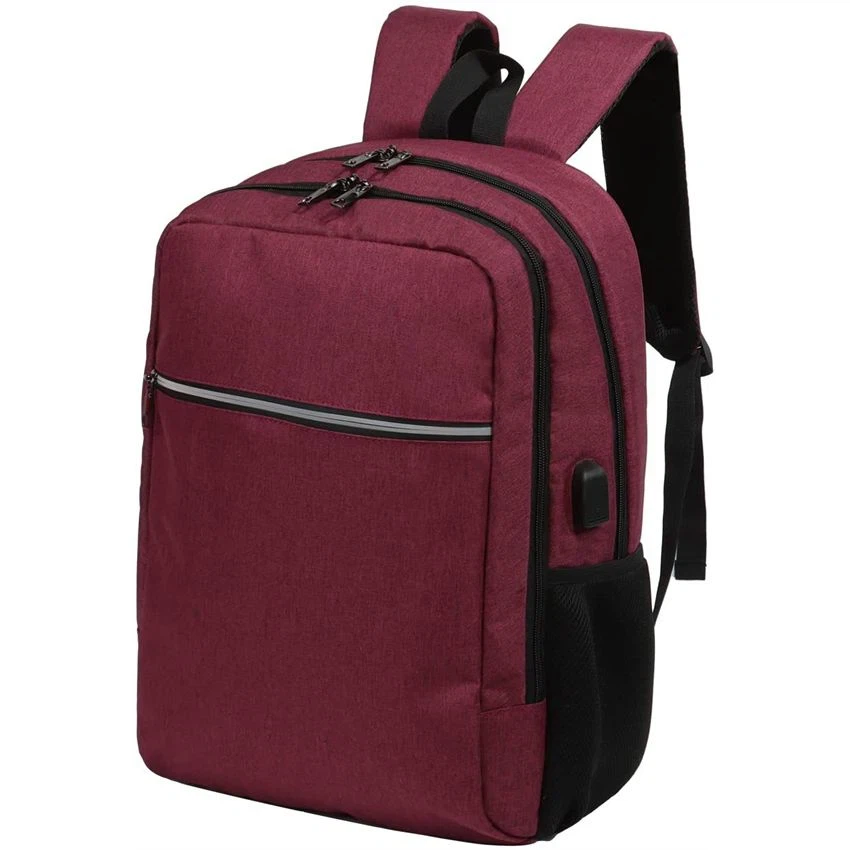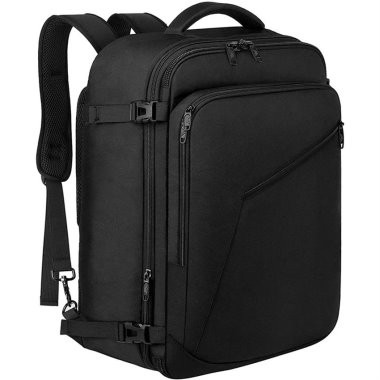A backpack is a bag worn on the back that is designed to carry things. It typically has straps that go over the shoulders and a compartment or compartments for storing items. Backpacks are popular for a variety of uses, including outdoor activities, travel, school, and everyday use. They come in a wide range of sizes, styles, and colors to suit different preferences and needs.
Advantages of Backpack
Convenient and versatile
Backpacks provide a convenient and versatile way to carry items. They can be worn on both shoulders, leaving your hands free and distributing weight evenly across your back, making them great for long walks or hiking.
Spacious
Backpacks are spacious and come in various sizes and styles, allowing users to carry a wide range of items. They usually have multiple compartments and pockets of various sizes, making them great for organization.
Comfortable
Backpacks designed with ergonomics in mind are comfortable to wear, especially for extended periods of time. Features like padded straps, back panels, and waist belts reduce strain on your shoulder and back, making them ideal for people who need to carry heavy loads.
Durable
A good quality backpack is typically durable and can withstand wear and tear. They are made from high-quality materials that can last for years, making them a worthwhile investment.
Security
Backpacks often come with security features such as lockable zippers, hidden pockets, and RFID protection for securing valuable items. Some even have anti-theft features, providing peace of mind when traveling or in crowded places.
Affordable
Backpacks are available in a wide range of prices, making them affordable for most budgets. You can find a good quality backpack for a reasonable price, making them an excellent option for students, travelers, or anyone who needs to carry items daily.
-
Large Capacity Business Laptop Backpack
Large capacity business laptop backpack is widely used in modern society because people need to use
Add to Inquiry -
Large Capacity Business Backpack
Large capacity business backpack is ideal for short trips because people can put all the things in
Add to Inquiry -
Three-in-one Computer Backpack
Three-in-one computer backpack is a new fashion trend.This unique laptop bag features an
Add to Inquiry -
All stitches are strengthened to suit long-term use.This foldable backpack provides enough space
Add to Inquiry -
There are two different colors for this lightweight weekender bag.They are black and grey.The
Add to Inquiry -
Rucksack sling bags are now in great demand,especially among young people.They are very light and
Add to Inquiry -
The mailbag is new design and it can be used by men and women.There are three different sizes of
Add to Inquiry
Why Choose Us
High quality
We take pride in the craftsmanship of our products and ensure that each one meets our strict standards for quality.
Professional team
The members of the team are highly skilled and proficient in their respective roles and possess the necessary education, training, and experience to excel in their jobs.
Good service
Customer service will update you the logistics information of the goods in time to ensure that the goods are delivered in time.
After-sales service
Our factory has more than 10 years of working experience researching and selling. All after-sale requests will be responded in 24 hours.
Types of Backpack
Daypacks
These are smaller backpacks designed for day trips, hikes, and short excursions. They typically have a capacity of around 20-35 liters and feature multiple pockets and compartments for organization.
Travel backpacks
These backpacks are designed for longer trips, where you need to pack more items but still want to carry everything on your back. They typically have a capacity of around 50-80 liters and feature a larger main compartment, as well as additional pockets and compartments for organization.
Hiking backpacks
These backpacks are designed for serious hikers, backpackers, and mountaineers. They typically have a capacity of 50-80 liters, with an external frame to support heavy loads and distribute weight evenly.
School backpacks
These backpacks are designed for students and typically have a capacity of 20-30 liters. They feature multiple compartments and pockets to help students stay organized and carry all the necessary books and supplies.
Fashion backpacks
These backpacks are designed with style in mind and often feature trendy designs and patterns. They can range in size and capacity and typically have fewer compartments for organization.
Work backpacks
These backpacks are designed for professionals who need to carry their laptop, documents, and other work-related items. They typically have a capacity of 20-35 liters and feature specialized pockets and compartments for laptops and other electronics.

Application of Backpack
Traveling
Backpacks are a popular choice for traveling, especially for backpackers and those who prefer to travel light. They can easily store clothes, gadgets, documents, and other essentials that travelers need on the road.
Hiking and camping
Outdoor enthusiasts often use backpacks for hiking and camping, as they are designed to carry heavier loads and are made of durable materials that can withstand harsh weather conditions.
School
Backpacks are a staple for students of all ages, as they provide a convenient way to carry books, gadgets, and other school supplies.
Work
Backpacks are also used by professionals who need to carry their laptops, documents, and other work-related items. They are particularly useful for people who commute to work or travel between different locations during the day.
Sports
Backpacks are widely used by athletes and fitness enthusiasts to carry sports equipment and gear, such as soccer balls, basketballs, and gym clothes.
Photography
Backpacks designed for photography are used by professional photographers and amateur enthusiasts to carry their cameras, lenses, and other photography accessories.
Military and tactical
Backpacks designed for military and tactical uses are made of specialized materials and feature various compartments and pockets to carry weapons, ammunition, and other military gear.
Components of Backpack




1.Main compartment:This compartment is typically located in the center of the backpack and is the largest section. It may have a zipper, drawstring, or flap closure and can be accessed easily.
2.Front pocket:This could include things like your phone, wallet, or keys. Some backpacks also have additional organizational pockets within the front pocket for even better organization.
3. Side pockets:They are often made from stretchy mesh material, allowing for easy access and flexibility in size to accommodate different items. Some side pockets may also have additional features such as drainage holes to allow for water to escape and prevent mold or mildew from developing.
4. Padded shoulder straps:The padding in the straps also helps absorb shock and reduce pressure on your shoulders, preventing soreness and fatigue. This is especially important if you're carrying a heavy load or hiking over rough terrain.
5. Chest strap:It also helps to distribute the weight of the backpack evenly across the body. This is particularly useful during activities such as hiking, trekking, and mountaineering, where the backpack can shift and move around. The chest strap keeps the backpack in place and reduces the strain on the shoulders.
6. Hip belt:It is a key component of many backpacks and can be adjusted for a secure and comfortable fit. The hip belt is typically padded for added comfort and often features a buckle or clip mechanism for easy adjustment and removal. The use of a hip belt helps to distribute weight evenly across the body, reducing strain on the shoulders and back and allowing for a more enjoyable and comfortable hiking or backpacking experience.
7. Back panel:It is usually found on backpacks or other types of bags that are meant to be carried for long periods of time. The padding provides cushioning against the user's back to help distribute the weight of the bag evenly. This helps to reduce the strain on the shoulders and back, which can be especially important for people who need to carry heavy loads or for long distances. The back panel may also be des
8. Compression straps:They also help to compress the backpack and make it more streamlined, reducing the overall bulk of the backpack. Compression straps can be found on the sides, top, and bottom of the backpack and may be adjustable or fixed in place.
9. Hydration system compatibility:Some backpacks have a compartment designed specifically to hold a hydration reservoir or water bladder and have a port to feed the hydration tube through.
10. Additional storage:Some backpacks come with additional compartments and features like a laptop sleeve, a rain cover, or a hidden pocket designed for valuables like passport or wallet.
Material of Backpack
Nylon
This is one of the most common materials used for backpacks. It is lightweight, durable, and water-resistant, making it great for outdoor activities.
Polyester
Similar to Nylon, polyester is also lightweight, durable, and water-resistant. It is often used for fashion backpacks, as it can be printed with various designs.
Leather
Leather backpacks are stylish and durable, but heavier than their synthetic counterparts. They are often used for school or office, where a more professional look is desired.
Canvas
Canvas backpacks are heavier and more durable than nylon or polyester, making them suitable for carrying heavier items or books. They are often used as school bags or for daily use.
Corduroy
Corduroy is a warm, cozy fabric that is often used for backpacks, especially for winter-use backpacks.
Ripstop
Ripstop nylon is a lightweight fabric that is often used in backpacks designed for outdoor activities like camping or hiking. It is tear-resistant, making it a durable option in rugged terrain.
How to Maintain Backpack
Clean your backpack regularly
Dirt and grime buildup can damage the fabric of your backpack. Therefore, it is important to clean it regularly. Use a damp cloth or sponge to wipe down the exterior of your backpack, and use a gentle brush to remove dust and debris from zippers and pockets.
Empty the backpack after each use
Leaving items inside your backpack when not in use can damage the fabric, zipper, and other components. Empty your backpack after each use to prevent this from happening.
Store your backpack properly
When you're not using your backpack, hang it up or pack it away in a dry and clean place. Avoid storing it in damp or humid areas as this can lead to mold growth and damage the fabric.
Repair any damage immediately
If you notice any tears, holes, or loose threads on your backpack, repair them as soon as possible. This prevents the damage from getting worse and prolongs the life of your backpack.
Protect your backpack from harsh weather
If you're traveling in rainy conditions, protect your backpack with a waterproof cover. Also, avoid leaving your backpack in direct sunlight for extended periods to prevent color fading and damage to the fabric.
Don't overload your backpack
Your backpack is designed to carry a certain amount of weight. Overloading it may cause damage to the frame or the stitching. Use your backpack within its weight limits to avoid any damage.
Before cleaning, it's important to read the care instructions on the backpack label to ensure that the cleaning method used won't damage it. The first step in cleaning a backpack is to empty all the contents, pockets, and compartments. Next, use a soft brush or cloth to remove any loose dirt, dust, or debris. A damp cloth or sponge with a mild detergent can be used to clean the backpack surface, rubbing gently in circular motions. Rinse the backpack with clean water and then dry it completely, preferably in the sun to avoid moisture and mildew growth. If the backpack has removable parts such as straps, they should be cleaned separately. Always avoid using harsh chemicals or bleach on a backpack as it can affect the backpack's quality and damage its fabric. Always make sure to follow the right cleaning method to avoid damaging your backpack as each backpack may need a different cleaning method.

Choose the appropriate size
There are different backpack sizes depending on your body type and the amount of gear you will be carrying. The backpack should fit snugly without being too tight or too loose.
Adjust shoulder straps
Adjust the shoulder straps so they fit snugly over your shoulders. Make sure the backpack sits in the middle of your upper back and the weight is evenly distributed. The straps should not dig into your shoulders or restrict your arm movement.
Adjust the sternum strap
The sternum strap connects the shoulder straps and helps to keep the backpack stable. Adjust the height of the sternum strap so it sits comfortably across your chest - not too high or too low. The strap should also be tight enough to hold the shoulder straps in place but not so tight that it restricts breathing.
Adjust the hip belt
The hip belt helps to transfer the weight of the backpack from your shoulders to your hips. Make sure the hip belt sits snugly around your waist and the padding rests on your hip bones. The hip belt should not be too tight or too loose – you should be able to slide your hands between your hips and the belt.
Load the backpack
Place heavier items at the bottom of the backpack and distribute the weight evenly. Make sure the backpack is not overloaded and that it is comfortable to wear. Adjust the straps and belt as necessary to balance the weight.
Check for comfort
Walk around with the backpack on your back to check for comfort and balance. Adjust the straps and belt as necessary until you find a comfortable fit.
What Are Some Important Features to Consider When Purchasing a Backpack
Capacity
The first thing to consider while buying a backpack is its capacity, which is the amount of gear that can be stored in it. The backpack should be large enough to carry all the necessary items, without being excessively bulky.
Comfort
The backpack must be comfortable to carry, especially when filled with heavy items. It should have a well-padded and adjustable harness to distribute weight evenly across the back, shoulders, and hips.
Material
The material of the backpack should be durable and water-resistant. Common materials used include nylon, polyester, and canvas.
Compartments
The backpack should have multiple compartments and pockets to allow for organization and easy access to items. A hydration compartment is also important for staying hydrated on long hikes.
Ventilation
Backpacks that allow proper ventilation near the back area help reduce sweat and prevent overheating during hot weather or strenuous activities.
Load-bearing capacity
The backpack should be able to bear the load of the gear without causing any discomfort. The load-bearing capacity is determined by the backpack’s frame, which can either be internal or external.
Zippers
High-quality zippers and pulls ensure easy and smooth opening and closing of compartments.
Warranty
A good warranty covering defects in materials and craftsmanship is crucial while making purchasing decisions.
Our company has been through professional quality system certification, CE certification, SGS audit, TUV audit, BSCI audit and as a socially responsible manufacturer, we also have stable and long-term cooperation with manufacturers of renewable fabrics.

certificate

FAQ
Q: What is a backpack and how is it different from a regular bag?
Q: What are some common materials used to make backpacks?
Q: Can backpacks be used for travel?
Q: What are some important features to consider when purchasing a backpack?
Q: How do you pack a backpack for travel?
Q: How do you measure the size of a backpack?
Q: How do you properly clean a backpack?
Q: What is a hydration backpack?
Q: Are backpacks waterproof?
Q: What is a backpacking backpack?
Q: Can a backpack be used for school?
Q: How do you choose the right backpack for school?
Q: Are there backpacks for specific sports?
Q: What is a tactical backpack?
Q: Can you travel with just a backpack?
Q: How do you prevent back pain when using a backpack?
Q: What is a frame backpack?
A frame backpack has a frame that is designed to distribute the weight of the backpack across the entire back. It is commonly used for hiking and camping.
Q: What is a rolling backpack?
Q: How do you adjust backpack straps?
Q: What is a hands-free backpack?







